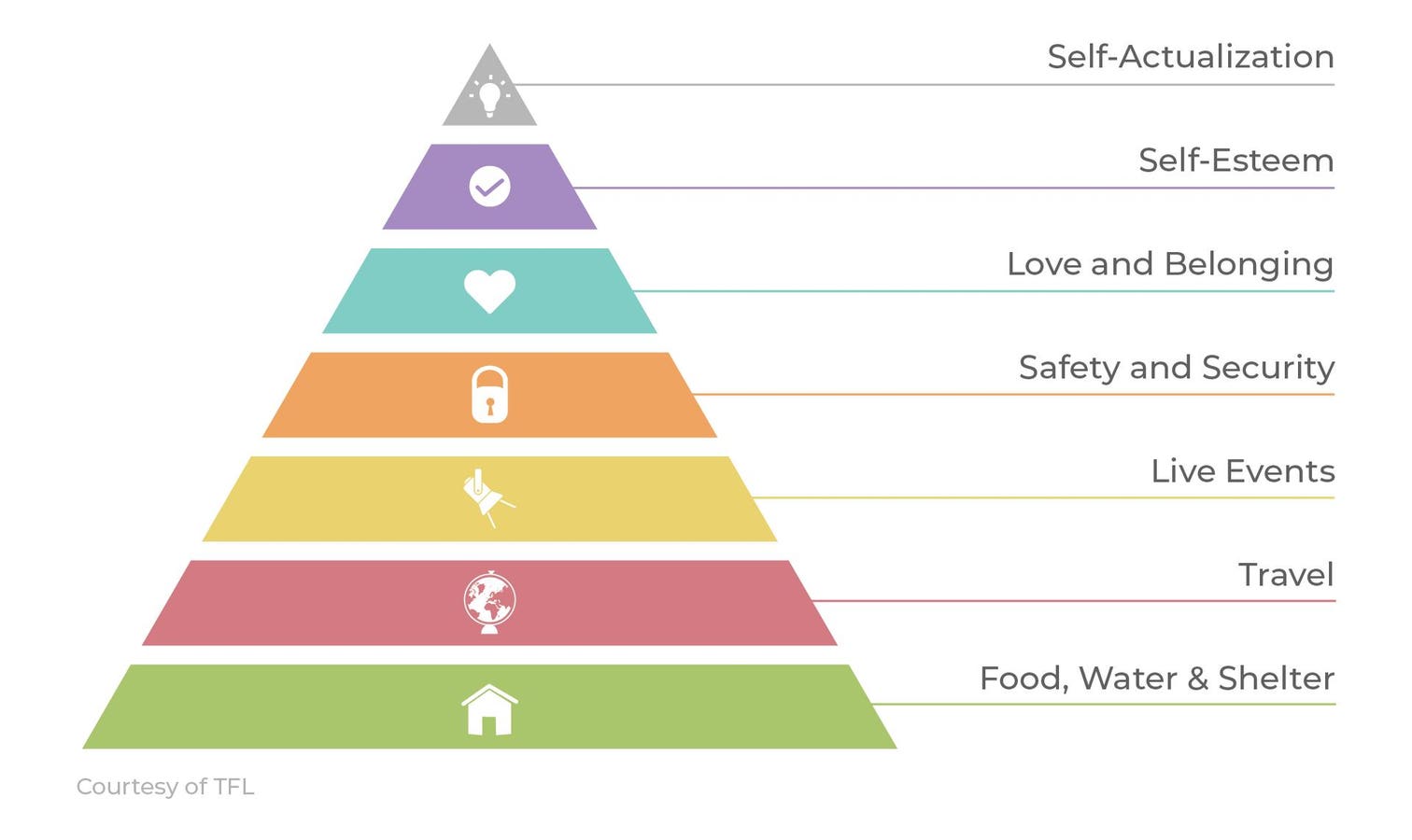Luxury experiences continue to proliferate from the spa not too far away to the culinary experience that requires a little planning. At the top of “Maslow’s Pyramid” for the discerning consumer travel and live events replace food, water and shelter. In an effort to dig deeper I leaned into experts at The Moorings, Abercrombie & Kent and Mindtrip to share perspectives.
Maslow’s Hierarchy of Needs Re-Imagined for The Experience Economy
Michelle Denogean, author and CMO at Mindtrip, a leading AI travel brand remarked, “Luxury travelers have distinct preferences and expectations when planning their journeys. The ability to craft personalized itineraries tailored to these needs is essential. For those venturing out independently, AI travel tools will play a critical role in 2025 and beyond, helping them navigate the overwhelming sea of information to uncover the unique, curated experiences they desire.”
Trend 1: Emerging Destinations and Accessibility
Travelers are increasingly drawn to destinations that offer both novelty and improved accessibility. Northern Morocco and Southern India are prime examples of this trend. New luxury accommodations, such as boutique riads in Marrakech and eco-friendly resorts in Kerala, cater to discerning travelers looking for unique stays. Enhanced connectivity—like direct flights from Newark to Marrakech and Entebbe to London—makes these destinations more convenient to access than ever before, encouraging exploration. Similarly, regions like the Amazon Rainforest and Northern Europe are gaining traction as travelers look to venture beyond crowded hotspots. These less-traveled areas provide a sense of discovery while showcasing pristine natural beauty and cultural authenticity.
Bedrooms at Sacha Lodge, an Amazon Rainforest lodge near Coca in Ecuador, South America. (Photo by: … [+]
Trend 2: Cultural and Culinary Immersion
The desire for meaningful connections to a destination is driving demand for cultural and culinary immersion. Travelers are no longer content with surface-level experiences—they want to delve deep into the heritage and gastronomy of the places they visit. In Vietnam, this trend is evident in the rise of Michelin-starred dining that highlights local flavors. In Tuscany, travelers are drawn to wine-making traditions and truffle festivals that celebrate the region’s bounty. Abercrombie & Kent caters to this demand by curating itineraries that include intimate, one-of-a-kind experiences. For example, guests can meet members of the Cochin Royal Family in Southern India, gaining insight into their history and culture, or wander the blue-washed streets of Chefchaouen in Morocco, a photographer’s dream that’s rich with Berber traditions.
According to Stefanie Schmudde, SVP Global Product Strategy at Abercrombie & Kent, “Travelers today seek authentic, immersive experiences that connect them to the rich cultural and culinary stories of a destination. We craft journeys that go beyond sightseeing—allowing guests to meet local artisans, explore hidden gems, and truly engage with the essence of a place.”
Trend 3: Adventure Meets Conservation
A growing emphasis on sustainability is shaping travel preferences, with eco-conscious travelers gravitating toward itineraries that combine adventure with conservation. Gorilla trekking in Uganda offers an unparalleled opportunity to witness endangered mountain gorillas while supporting the Uganda Wildlife Authority’s preservation efforts. Similarly, polar bear spotting in the Arctic draws attention to the importance of protecting fragile ecosystems affected by climate change. Abercrombie & Kent is at the forefront of this trend, integrating conservation initiatives into its trips to ensure that tourism supports local communities and protects biodiversity for future generations.
Ms. Schmudde elaborated, “Abercrombie & Kent’s commitment to conservation runs deep, rooted in the vision of our founder Geoffrey Kent, who helped establish Uganda’s first luxury property to protect endangered mountain gorillas. This legacy continues today, offering guests the chance to witness these magnificent creatures in their natural habitat while directly supporting their preservation through sustainable tourism.”
Trend 4: “Cool-cations” and Seasonal Shifts
Cooler climate destinations are becoming increasingly attractive as travelers seek alternatives to traditional summer beach vacations. Regions like Northern Europe and the Arctic captivate with dramatic landscapes, vibrant wildlife, and outdoor adventures. Fjord cruises, hiking in the Nordic countryside, and Arctic expeditions offer unforgettable ways to embrace nature’s raw beauty. This shift also reflects a growing interest in seasonal travel that aligns with natural phenomena, such as the midnight sun or the Northern Lights, adding an extraordinary element to the vacation experience.
Trend 5: Rising Popularity of Private Jet Travel
According to Ann Epting, Senior Vice President of Private Jet & Special Interest Travel at Abercrombie & Kent, “Travelers are seeking seamless, time-efficient, and personalized experiences, making private jet travel increasingly appealing. It offers a level of comfort and access that’s unparalleled, allowing guests to explore the world’s most remote and extraordinary destinations in a way that aligns with their schedules and preferences.”
Trend 6: Slow Travel
As defined by Conde Nast Traveler, Slow Travel is “an intentional move toward more mindful, more environmentally responsible, less purely convenient modes of getting around. Slow Travel means tamping down our own built-in, conditioned obsessions with time and allowing the world to move just a little slower so that we can actually notice it.” This is perhaps a uniquely American problem – even our vacations seem rushed, and we feel pressured to get the most out of every minute. But there seems to be more of a conscious effort to slow down, and truly disconnect than ever before.
Thinking of slow travel, I had the opportunity to visit with Björn Bender, President & CEO of Rail Europe at the Phocuswright Conference where he noted, “In today’s travel landscape, technology is reshaping how we experience the world. At Rail Europe, we serve as a one-stop shop for train travel, providing access to over 200 train providers across Europe. This allows travelers to effortlessly plan and book their journeys from A to B and beyond. We recognize that modern travelers seek not only convenience but also meaningful experiences. We empower individuals to focus on what truly matters-enjoying their adventures, making memories, all while connecting with the unique cultures and landscape of Europe.”
Trend 7: Blue Mind
“Blue Mind” is a term coined by marine biologist Wallace J. Nichols, in which he defines the positive effects that being on or around water has on human health and mental well-being. In a book titled Blue Mind: The surprising science that shows how being near, in, on, or under water can make you happier, healthier, more connected, and better at what you do, Nichols outlines how simply being near bodies of water can have a positive physiological effect on people nearly universally, allowing you to reach a near-meditative state.
“In many ways the world at large is discovering what our guests have understood for decades – that a yachting vacation is the ideal way to slow down and truly capture the moment”, commented Ian Pedersen, Senior Marketing Manager for The Moorings, a premier global yacht charter company that offers small groups an opportunity to experience life on the water.
Pedersen continued,”This isn’t a cruise, this is private yacht just for you and your immediate family or friends, creating a truly immersive and flexible environment which allows our guests to experience so much more of their chosen destination than they would with a more traditional type of vacation.”
Trend 8: Grand Gatherings
Grand Gatherings is a newer trend, in which people are traveling together in small, private groups, whether it be with extended family, mutigenerational groups, or with friends. This is about connection, spending quality time with those you care about in a meaningful way beyond just your immediate household.
“When you look at how brands advertise travel, the most popular images still depict people alone or isolated, typically outdoors and usually on a beach. That’s not necessarily the ‘dream vacation’ anymore. After the isolation of the pandemic, togetherness is more important to people than ever before, and that absolutely extends into travel,” said Sammy Malave Jr., Creative Insights Lead at Getty Images. “While ‘getting away from it all’ has always been a purpose of travel, we’re seeing the emergence of a ‘new escapism’ focused on experiences that bring a sense of community and social nourishment; brands that tap into that desire are going to build more authentic connections with today’s travelers.”
With the experience economy there is no need to be a multi-millionaire and invest in buying a yacht to experience life on the water. The yacht charter industry, spearheaded by companies like The Moorings, offer small groups a chance to experience life on the water.
We talk a lot about “luxury” and what that means. In this case, luxury is the absence of hustle and noise. It is the full disconnection that we aspire to find. It is the ability to enjoy without owning. It’s feeling like you found more “time and space” which is a valuable commodity to discerning, affluent consumers.
Luxury Travel On The Rise
I reviewed online data from Grand View Research that suggests the luxury market will increase by a CAGR – compound annual growth rate of 7.9% annually. Given a market size of over $1.4 Trillion that hefty CAGR will attract interest and likely new investment.
According to Mike Landry, a Tumi executive, “Thanksgiving 2024 saw an all-time daily TSA screening record broken. Upmarket cruise lines report unprecedented advance bookings. Marriott recently announced 260 luxury properties in its development pipeline, roughly a 50% increase from its current portfolio. Every metric including the strong interest Tumi has seen from their premium collection tells us that upscale travel is back.”










